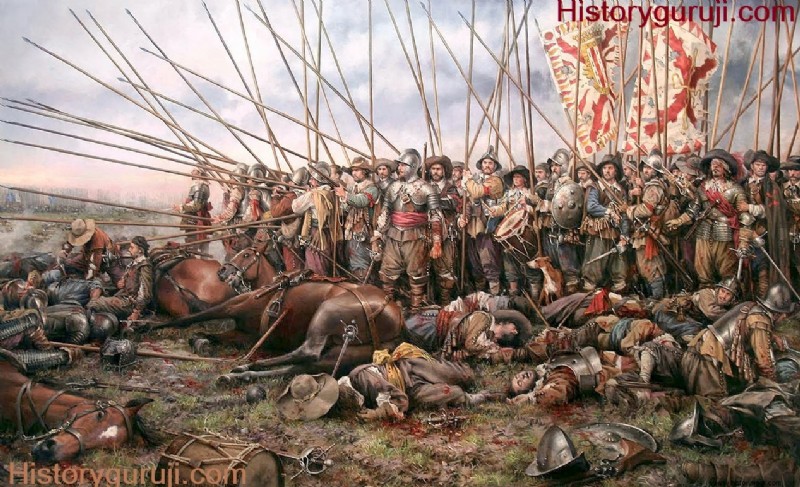
History of Europe In the Thirty Years' War It is a milestone from where all the remnants of the medieval period end and the real journey of the modern period begins. This war, which started in 1618 AD, was not a war but a series of many wars, in which the war was fought on German soil, but the warriors participating in the war were mostly non-German. In a way, the Thirty Years' War was the first all-European war in which all the major countries of Europe participated. Apart from Germany, the armies of Spain, Denmark, Sweden, Holland and France participated in this war fought on German soil.
The Thirty Years' War was the deadliest final religious war in Europe. Another feature of this war was that this war was started for religious reasons, in which Catholic countries were on one side and Protestant countries on the other, but in the last phase of the war religious reasons went into the background and political point of view became important. The reason for this was that the Catholic country France intervened in the war by supporting the Protestant states of Germany by not taking the side of the Catholic states. French Prime Minister Richelieu wanted to undermine the power of the Habsburg dynasty and establish the supremacy of the Bourba dynasty of France in Europe.
b
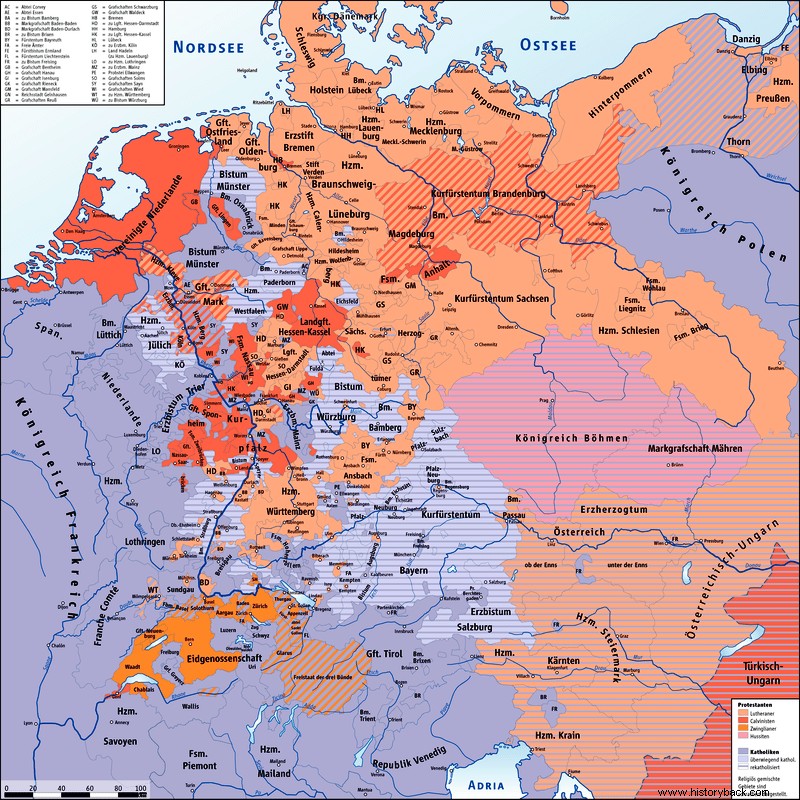
Agsberg to the ongoing competition between Catholics and Protestants The treaty clauses failed to control. In fact, the competition to capture as many churches as possible and capture their immense wealth had rendered the Treaty of Augsburg ineffectual. This competition between Catholics and Protestants led to the communal riots of the city of Donaworth in 1606 AD. Protestants had a majority in this city, but gradually the number of Catholics also started increasing. In 1603 AD, when Catholics started taking out religious processions with flags, the council of this Protestant city opposed it. The Catholics took out a provocative procession in September 1606 with an immediate order from the Imperial Court, which led to a riot in the city. At this time Rudolf was the Holy Roman Emperor. He entrusted the responsibility of investigating this riot and providing security to the minority Catholics to the Duke Maximilian of Bavaria.
Maximilian was a staunch Catholic and without wasting time in April 1607, instructed the city council not to interfere with the religious freedom of Catholics and allow them to take out religious processions. . When the city council refused to obey this order, on 12 November, an imperial ban was imposed on the city. In September, Maximilian captured the city with the help of the army. Dissatisfied with the actions of Maximilian, the Protestant kings of Germany founded the 'Protestant Union' on 16 May 1608. The Protestant Union He also had the patronage of Emperor Henry IV of France. In response to this, within a year Maximilian of Bavaria organized the Catholics 'Catholic League ' established. This league was also supported by the Emperor of Spain.
At the same time the problem of succession in Cleves-Jülich gave rise to the possibility of war as the king there, the duke, had died without a male heir. Both his immediate successors were Protestants, raising the possibility of increasing Protestant influence in the region. The Protestant Union and Emperor Henry IV had started preparing for war, but at the same time Henry IV was killed, due to which the Protestants were not left in a state of war. An attempt was made to end this crisis by a treaty in 1614 AD, according to which Jülich was given to Louis Philippe, a Catholic king, and Cleves, a Protestant ruler, to the Elector of Bredenburg. But this did not avert the crisis and soon a situation arose in Germany, which made the Thirty Years' War inevitable.
Because of the Thirty Years' War
Due to the Reformation Movement, Germany was divided into two religious factions - Catholics and Protestants. The conflict between Roman Catholics and Lutheranists in Germany was ended by the Treaty of Augsburg of 1555 AD, but after this treaty, a real and permanent religious settlement in Germany was not possible. Only Roman Catholics and Lutheranists were recognized in the Treaty of Augsburg, while after 1555 AD, the Calvinists were also increasing in influence in Germany and they were also demanding equality. The Treaty of Augsburg prohibited the confiscating or confiscating Roman Catholic Church property, but German Protestants violated this provision by confiscating Catholic Church property. On the other hand, the attitude of the Catholics of Germany was also becoming more aggressive and they wanted to completely eliminate Protestantism from Germany. In addition, the Protestant kings of Germany were also beginning to scramble to break free from the political control of the Holy Roman Emperor. The question of Bohemia arose in this agitated atmosphere, which eventually led to the Thirty Years' War. The causes of the Thirty Years' War can generally be divided into three parts - religious reasons, political reasons and immediate causes.
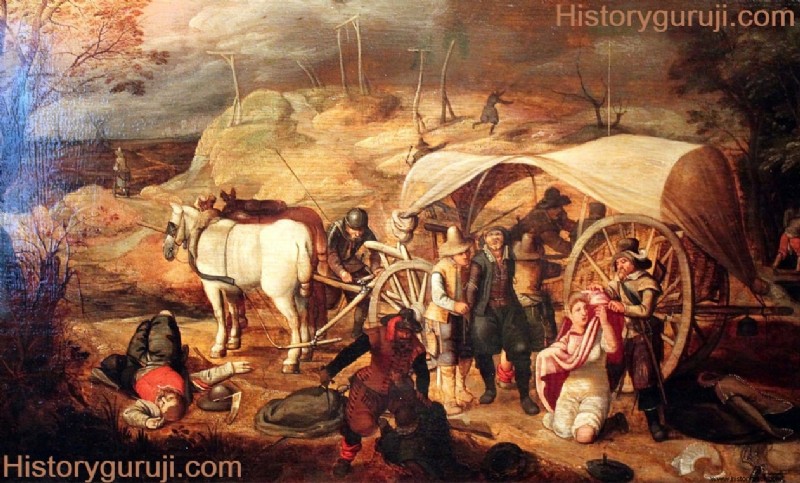
religious reasons
The Thirty Years' War was started for religious reasons. Religious disputes did not end with the Treaty of Augsburg of 1555 AD, but the seeds of future dispute were present in this treaty. According to this treaty - every ruler of Germany got the right to determine the religion of his state. This meant that the religion of the people was determined by the ruler. Second, it was necessary for the ruler to adopt either Roman Catholicism or Lutheranism. He could not adopt any other religion. Third, the treaty stated that if a Catholic bishop adopted Lutheranism, he would have to relinquish all rights to his episcopal position. Fourth, the treaty provided for the protection of the property of the Catholic Church. The treaty said that after January 1, 1552 AD, the property of the Roman Catholic Church would be preserved, but before that the property of the Catholic Church that had gone into the hands of Protestants would not change and would remain with the Protestants. Will remain the same.
These provisions of the treaty caused many problems - one problem was that the kings got the right to determine the religion of their subjects. It did not say anything about the rights of the people. The second problem was that the treaty recognized only Lutheranism as a Protestant religion, while Calvinism was becoming increasingly influential and was not recognized. The result was that the Calvinists later formed a league for their protection, which led to the start of the Thirty Years' War. The third problem was that the provision of religious protection of property was not followed properly and this led to many disputes. Catholics said that after January 1, 1552 AD, the property of the bishops who had become followers of Protestant religion should be returned. In contrast, the Protestant rulers were unwilling to return this property. Thus the bitterness between the two sects increased.
Thus a solution to the religious problem of the Holy Roman Empire was anticipated by the Treaty of Augsburg in 1555 AD, but this hope failed on two important issues. First, the Catholic Church property secularization restriction was completely disregarded. Secondly, it only recognized Catholics and Lutheranists, but did not recognize Calvinists. Later on, the influence of Calvinists increased in central and southern Germany and Bohemia and they demanded equal rights, which led to the start of the Thirty Years' War.
political reason
The causes of the Thirty Years' War were not only religious, but political reasons were also involved from the beginning. The hereditary ambitions of the dynasties were also added to these political reasons, such as the Habsburg dynasty ruler of Austria was also emperor of the Holy Roman Empire (Germany). He wanted to establish his autocratic and sovereign power over the Holy Roman Empire, but the monarchs in Germany wanted to preserve their traditional freedoms and rights. But there was no unity among these kings and some kings supported the emperor for their selfish interests. The emperor was also helped by the Habsburg dynasty ruler of Spain. Secondly, the expansion of the Habsburg dynasty made France worried about its security. Apart from Austria, the rulers of this dynasty ruled over Spain, Netherlands, French Comte, Milan, Sicily. France felt that it was surrounded by Hapsburg regions. So France wanted to break this circle. French Prime Minister Richelieu wanted to extend France to the Rhine River in Germany. His aim was to make France the all-powerful state of Europe. So he wanted to weaken the power of the Austrian emperor by interfering in Germany.
Thirdly, the ambition of the Baltic states and the increasing trade in the Baltic Sea were also a reason for this war. This trade was controlled by Denmark. Sweden had also taken control of the eastern coast of the Baltic Sea at this time and now wanted to take over the northern part of Germany and make the Baltic Sea a Swedish lake. Denmark also wanted its expansion into Germany. Therefore, these political interests also had an effect on the Thirty Years' War.
Urgent Reason: The Rebellion of Bohemia (Urgent Cause:Bohemia Rebellion)
The immediate cause of the Thirty Years' War was the rebellion of Bohemia against the Austrian Empire. The people of Bohemia belonged to the Czech race and were followers of Calvin religion. Politically Bohemia was a kingdom of the Austrian Empire and for more than a century, the Catholic Monarchs of Austria had ruled Bohemia. After the death of Emperor Mathias in 1618, Ferdinand became the emperor of Austria. Ferdinand was a staunch Catholic and was against giving any kind of facilities to Protestants.
The Czech people of Bohemia feared that they would be forcibly converted to Catholicism. At the same time the emperor banned gatherings of Protestant people and removed Protestants from administrative positions. She publicly wrote 'Letter of Majesty ' and expelled those farmers cultivating the princely land who did not accept Catholicism. This strengthened the fears of the people of Bohemia and they decided to revolt. In this atmosphere of tension, on 22 March 1618, Emperor Ferdinand sent two of his representatives to Prague, the capital of Bohemia, to negotiate with the Czech people, but the atmosphere became so acrimonious that in anger, the Czech Protestants attacked both the representatives of the emperor - Jaroslav Martinitz. And threw William Slavata down the window. Although they both survived, it was an open challenge to the authority of the Emperor and the Catholic League.
Emperor Ferdinand sent an army to crush the Bohemia rebellion. On this, the Protestants of Bohemia announced the depose of Ferdinand and on 26 August 1618 AD, Frederick, the Elector of the Palatinate, was declared King of Bohemia. Frederick, the elector of the Palatinate, was a Protestant and was the leader of the Protestant League. Frederick was the husband of Elizabeth, daughter of King James I of England. This gave confidence to the rebel Protestants that they would get the support of England. Thus the Bohemia rebellion triggered a war between the Protestant and Catholic Leagues which lasted for thirty years.
Events of War
The Thirty Years' War can be divided into four parts in terms of events- 1. Bohemian or Palatinate period (1618-1624 AD), 2. Danish period (1625- 1629 AD), 3. Swedish period (1630-1635 AD) and 4. French period (1635-1648 AD).
1-. Bohemian or Palatinate period (1618-1624 AD)
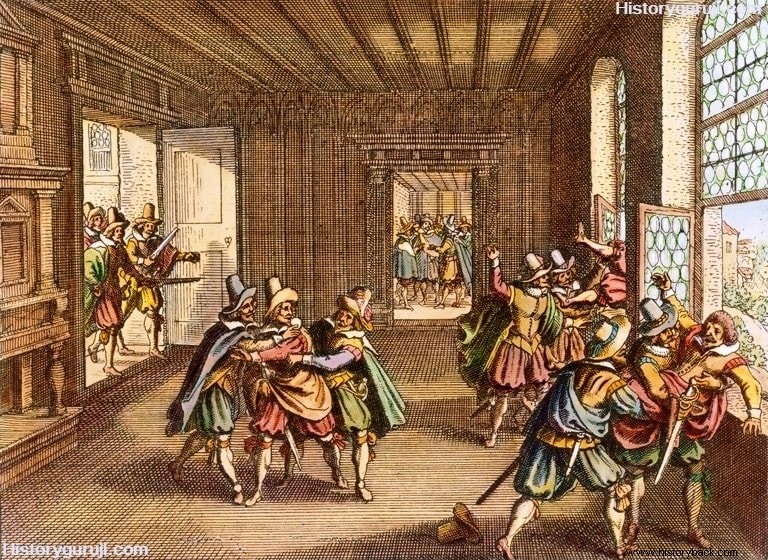
War in Bohemia and Pelitnet in the First Six Years Happened. Emperor Ferdinand II sought help from King Philip II of Spain. Philip II sent a large army under the command of Count Tilly, the general of Bavaria. Frederick hoped to get help from his father-in-law, King James I of England, but James I could not send aid due to internal problems. Frederick, on the other hand, did not receive aid from the Protestant rulers of Germany. ऐसी स्थिति में टिली ने फ्रेडरिक को 1620 में व्हाइट हिल के युद्ध में पूर्णरूप से पराजित कर दिया। टिली ने संपूर्ण बोहेमिया पर अधिकार कर लिया। प्रोटेस्टेंट लीग को भंग कर दिया गया। अनेक चेक नेताओं को प्राणदंड दिया गया और बोहेमिया पर बलपूर्वक कैथोलिक धर्म थोप दिया गया। पेलिटनेट भी प्रेडरिक के हाथों से निकल गया और उस पर बवेरिया के राजा मैक्सीमिलियन की सेनाओं ने अधिकार कर लिया। इन विजयों से कैथोलिकों का उत्साह बढ़ गया और स्पेन ने डचों से पुनः युद्ध आंरभ कर दिया ताकि खोये हुए नीदरलैंड को पुनः स्पेनिश अधिकार में लाया जा सके। इस काल में सर्वत्र केथोलिकों को विजय मिली।
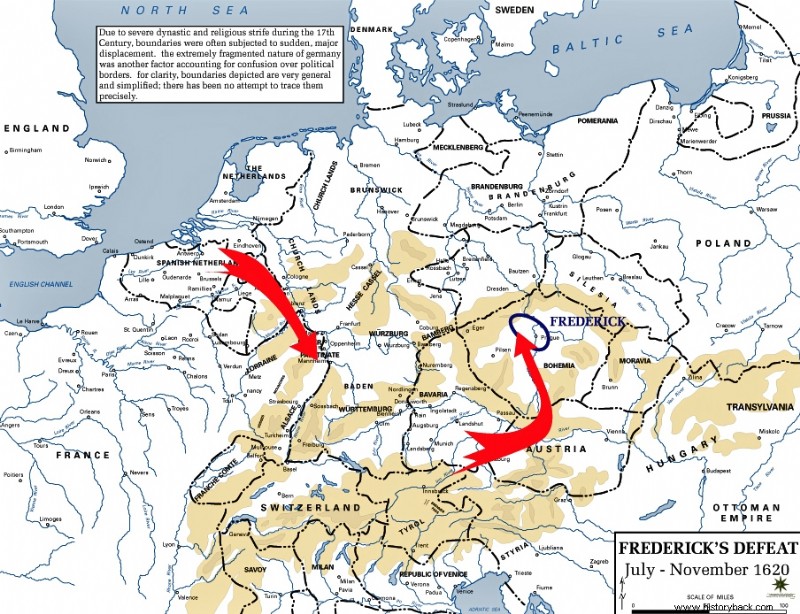
2. डेनिश काल (1625-1629 ई.)
कैथोलिकों की विजय से जर्मनी के लूथरवादी राजकुमारों में भय उत्पन्न हो गया। वे अभी तक तटस्थ रहे थे, लेकिन बोहेमिया पर फर्डिनेंड तथा पेलिटनेट पर बवेरिया के अधिकार से जर्मनी में ’शक्ति संतुलन’ नष्ट हो गया था। इसके अलावा, फर्डिनेंड ने इन राजंकुमारों को किसी प्रकार की स्वतंत्रता व धार्मिक अधिकार देना भी अस्वीकार कर दिया। ऐसे संकट काल में डेनमार्क के राजा क्रिश्चियन चतुर्थ ने अपने सहधर्मियों की सहायता से युद्ध में हस्तक्षेप किया। इसके कई कारण थे- एक तो, प्रोटेस्टेंट धर्म की रक्षा का प्रश्न था। वह जानता था कि यदि कैथोलिकों ने जर्मनी में पूर्ण सफलता प्राप्त कर ली तो वह भी सुरक्षित नहीं रहेगा। इसके अतिरिक्त उसके राज्य का एक हिस्सा हाल्सटीन जर्मनी साम्राज्य में पड़ता था। उसकी साम्राज्यवादी आकांक्षाएँ भी थीं। वह जर्मनी के कुछ छोटे धर्म राज्यों को जीतकर वहाँ अपने द्वितीय पुत्र को राजा बनाना चाहता था। वह उत्तरी सागर के तटीय क्षेत्रों पर अपन प्रभाव का विस्तार करना चाहता था। उसकी आकांक्षाएँ तभी पूरी हो सकती थीं जब प्रोटेस्टेंट लोगों को विजय प्राप्त हो। 1625 ई. में क्रिश्चियन चतुर्थ ने उत्तरी जर्मनी पर आक्रमण किया। इस आक्रमण में उसे इंग्लैंड के राजा चाल्र्स प्रथम, नीदरलैंड के डचों और जर्मनी के प्रोटेस्टेंट राजकुमारों से सहायता मिली। सम्राट फर्डिनेंड ने उसके विरूद्ध प्रतिभाशाली सेनापति वेलेंस्टाइन को भेजा। वेलेंस्टाइन और टली की सेनाओं ने लट्टर नामक स्थान पर क्रिश्चियन चतुर्थ को पराजित कर दिया। इस प्रकार उत्तरी जर्मनी से डेनिश सेना को निकाल दिया गया, लेकिन नौसेना के अभाव के सम्राट डेनमार्क पर आक्रमण नहीं कर सका। अंततः क्रिश्चियन चतुर्थ ने ल्यूेक की संधि करके युद्ध समाप्त कर दिया।
इस सफलता से प्रोत्साहित होकर फर्डिनेंड मे कठोर कदम उठापा। उसने 1629 ई. में ‘संपत्ति वापसी की घोषणा’ की, जिसके अनुसार 1555 ई. के बाद कैथोलिक चर्च की जो भी संपत्ति जब्त की गई थी, वह सब कैथोलिक चर्च को वापस कराई गई। इस कार्य से सभी प्रोटेस्टेंट अत्यंत भयभीत हो गये और उन्होंने कठोर प्रतिरोध का निश्चय किया। इस समय स्वीडन के राजा गस्टवस एडोल्फस ने, जो लूथरवादी था, जर्मनी के प्रोटेस्टेंटों के पक्ष में हस्तक्षेप किया।
3. स्वीडिश काल (1630-1635 ई.)
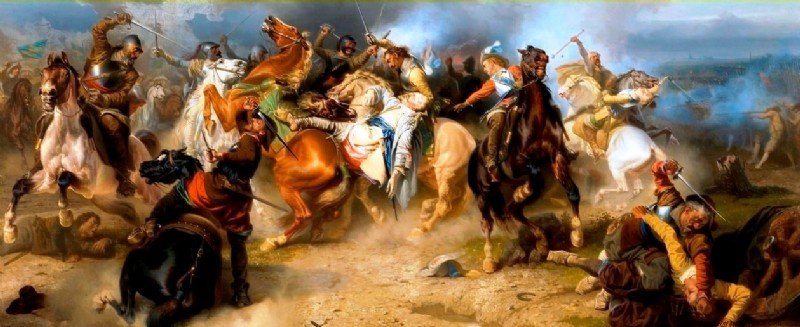
स्वीडन का शासक गस्टवस एडोल्फस योग्य तथा महत्वाकांक्षी शासक था। उसने रूस और पोलैंड को पराजित कर बाल्टिक सागर के पूर्वी तट पर विशाल क्षेत्र प्राप्त कर लिया था। वह उत्तरी जर्मनी के तटीय प्रदेशों को अधिकृत करके बाल्टिक सागर को स्वीडिश झील बनाना चाहता था। उसकी प्रोटेस्टेंट धर्म में अपूर्व आस्था थी और जर्मनी के प्रोटेस्टेंटों की रक्षा करना वह अपना कर्तव्य समझता था। इस समय फ्रांस के प्रधानमंत्री रिशलू ने तीसवर्षीय युद्ध में सक्रिय रुचि लेना आरंभ कर दिया था। रिशलू कैथोलिक था और एक धार्मिक अधिकारी कार्डिनल के पद पर था। किंतु तीसवर्षीय युद्ध में उसके हस्तक्षेप का उद्देश्य हैब्सबर्ग राजवंश को नीचा दिखाना था, ताकि फ्रांस के बूर्बा राजवंश की सर्वोच्चता का मार्ग प्रशस्त हो सके। उसने गस्टवस एडोल्फस के साथ संधि की और उसे धन तथा अस्त्र-शस्त्रों की सहायता दी। 1630 ई. में गस्टवस ने उत्तरी जर्मनी में अपनी सेना के बलपर युद्ध का रुख बदल दिया। कैथोलिकों ने मेग्डेबर्ग को जीतकर बुरी तरह लूटा। इससे जर्मनी के प्रोटेस्टेंट शासक आतंकित हो गये और उन्होंने गस्टवस से सहयोग करने की घोषणा कर दी। गस्टवस ने बवेरिया पर आक्रमण किया, जिसमें टिली पराजित हुआ और मारा गया। अब गस्टवस वियेना की ओर बढ़ा। भयभीत होकर सम्राट ने वेलेंस्टाइन को पुनः सेनापति नियुक्त किया। 1632 ई. में गस्टवस ने वेलेंस्टाइन को पराजित कर दिया, लेकिन अपने दुस्साहस के कारण गस्टवस भी मारा गया। इस प्रकार जीत हार में बदल गई। अब स्वीडिश सेना युद्ध जारी रखने की स्थिति में नहीं थी। 1634 में सम्राट की सेना ने उसे पराजित कर दिया और उसे जर्मनी छोड़कर वापस लौटना पड़ा। 1632 ई. के बाद वेलेंस्टाइन ने प्रोटेस्टेंटों से समझौता करने के लिए जो वार्ता आरंभ की थी, उसे कैथोलिकों ने पसंद नहीं किया। फलस्वरूप उन्होंने षड्यंत्र करके वेलेंस्टाइन की हत्या करवा दी।
इस समय तक दोनों पक्ष युद्ध से थक चुके थे। जर्मनी का पूर्ण आर्थिक विनाश हो गया था, अतः दोनों पक्षों में प्राग की संधि हो गई। संभवतः इस संधि से युद्ध समाप्त हो जाता, लेकिन फ्रांस के प्रधानमंत्री रिशलू ने युद्ध जारी रखने का निर्णय किया। इससे शांति स्थापित नहीं हो सकी।
4. फ्रांसीसी काल (1635-1648 ई.)
फ्रांस के प्रधानमंत्री रिशलू प्राग की संधि के पक्ष में नहीं धा। इसलिए उसने प्रत्यक्ष हस्तक्षेप का निर्णय किया। अभी तक उसने स्वीडेन तथा जर्मनी के प्रोटेस्टेंटों को धन व अस्त्र-शस्त्रों की सहायता दी थी। युद्ध की घोषणा करने से पूर्व उसने स्वीडेन, हालैंड तथा सेवाय से संधि कर ली थी। फ्रांस के हस्तक्षेप से अब युद्ध का रूप बदल गया। फ्रांस एक कैथोलिक देश था जो जर्मनी के प्रोटेस्टेंटों के पक्ष में आस्ट्रिया तथा स्पेन जैसे कैथोलिक देशों से युद्ध कर रहा था। स्पष्ट था कि युद्ध अब धार्मिक के बजाय राजनीतिक हो गया था। प्रारंभ में फ्रांसीसी सेना को पराजित होना पड़ा, लेकिन 1637 में उसने स्पेनी सेना को पराजित करके नीदरलैंड्स तथा राइन प्रदेश से निकाल दिया। इसके बाद फ्रांसीसी सेना ने कई स्पेनी प्रदेशों को जीत लिया। स्पेन के विरुद्ध पुर्तगाल, नेपल्स और अरागान में विद्रोह हो गये। 1643 ई. में फ्रांसीसी प्रतिभाशाली सेनापति कोंडे ने निर्णायक रूप से स्पेनी सेना को पराजित कर दिया। स्पेन की पराजय के पश्चात् फ्रांस और स्वीडेन की संयुक्त सेनाओं ने जर्मनी में प्रवेश किया। 1648 ई. में उन्होंने सम्राट और बवेरिया की सेना को बुरी तरह पराजित किया। इससे आस्ट्रिया की राजधानी वियेना के लिए संकट उत्पन्न हो गया। सम्राट युद्ध से थक गया था और अब जीत की कोई संभावना नहीं थी। अंत में, संधि वार्ताएँ आरंभ हुईं जिनके फलस्वरूप 1648 ई. में वेस्टफेलिया की संधि से युद्ध समाप्त हो गया।
1642 ई. में रिशलू को मृत्यु हो चुकी थी। उसकी नीति को उसके उत्तराधिकारी मैजरिन ने जारी रखा और रिशलू के उद्देश्यों के अनुसार ही उसने संधि की शर्तों को तय किया।
वेस्टफेलिया की संधि, 1648 ई. (Treaty of Westphalia, 1648 AD)
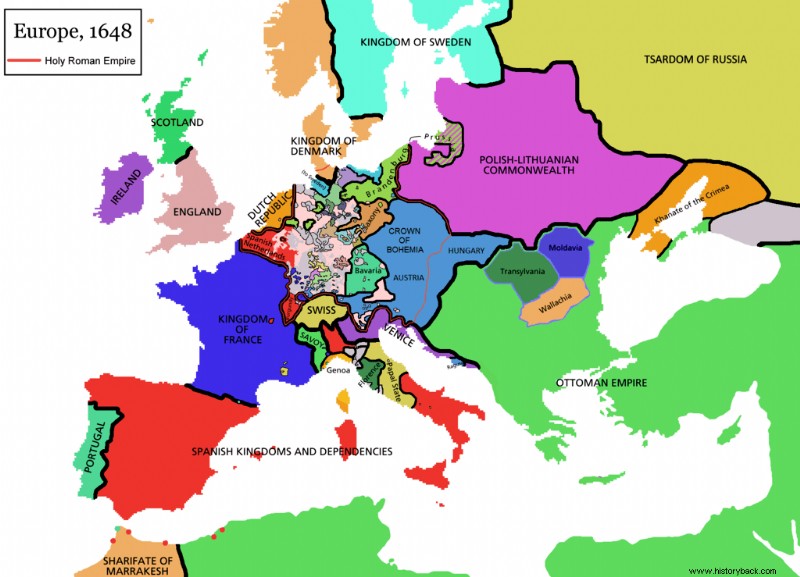
1648 ई. की वेस्टफेलिया की संधि के द्वारा तीसवर्षीय युद्ध समाप्त हो गया। इस संधि की धाराएँ निम्नलिखित थीं-
पवित्र रोम साम्राज्य का बाह्य स्वरूप तो वैसा ही बना रहा, लेकिन प्रत्येक सदस्य राज्य को सार्वभौमिक अधिकार प्रदान कर दिये गये। कोई भी राज्य युद्ध और शांति का निर्णय कर सकता था, लेकिन यह सम्राट के विरुद्ध न हो।
फ्रांस को अल्सास प्रांत और मेट्ज, तूल और वर्दुन के किले प्राप्त हुए। स्ट्रासबर्ग को नगर रखा गया।
स्वीडन को पश्चिमी पोमेरेनिया, ब्रेमन तथा वडेंन के प्रदेश प्रदान किये गये।
फ्रांस और स्वीडेन को जर्मनी डायट में अपने प्रतिनिधि भेजने का अधिकार मिला।
बेंडेनबर्ग को पूर्वी पोमेरेनिया, मेंडेबर्ग तथा कुछ विशपरकें प्राप्त हुईं।
पेलिटनेट के दो भाग किये गये- उत्तरी भाग बवेरिया तथा दक्षिणी भाग प्रेडिरक के पुत्र को दिया।
स्विट्जरलैंड और नीदरलैंड्स को पूर्ण स्वतंत्र राज्य माना गया।
काल्विनवादियों को भी मान्यता प्रदान की गई।
1624 ई. के पूर्व कैथोलिक या प्रोटेस्टेंट चर्चों के पास जो संपत्ति थी, वह उन्हीं की मानी जायेगी।
साम्राज्य के न्यायालयों में कैथोलिक तथा प्रोटेस्टेंट न्यायाधीश समान संख्या में होंगे।
तीसवर्षीय युद्ध का परिणाम (Results of the Thirty Years’ War)
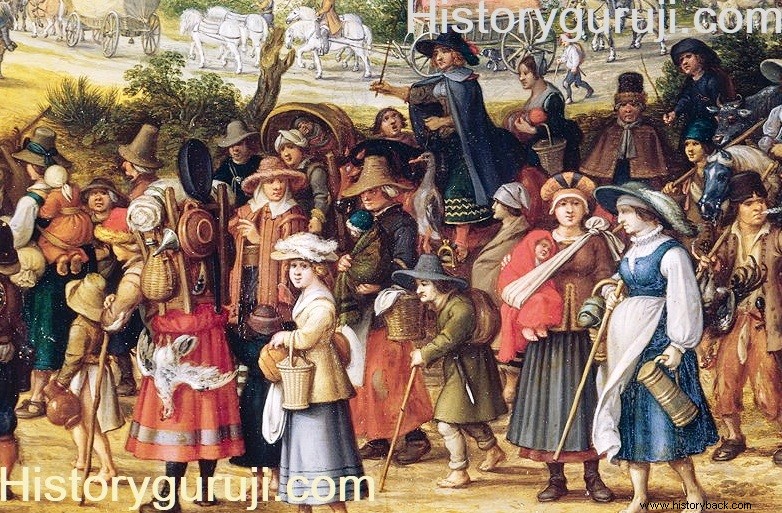
तीसवर्षीय युद्ध और वेस्टफेलिया की संधि का आधुनिक यूरोप के इतिहास में महत्वपूर्ण स्थान है। इस युद्ध से यूरोप में व्यापक राजनीतिक परिवर्तन हुए। इसने मध्ययुगीन परंपराओं को समाप्त करके आधुनिक प्रवृत्तियों को आरंभ किया-
नवयुग का आरंभ
इस युद्ध ने धार्मिक समस्याओं को हल कर दिया। काल्विनवादियों के मान्यता प्राप्त हुई। कैथोलिकों की संपत्ति के अपहरण को रोका गया। कैथोलिक तथा प्रोटेस्टेट धर्मों का संघर्ष समाप्त हो गया। युद्ध ने धर्म-सुधार युग को समाप्त कर दिया। इससे स्पष्ट हो गया कि राजनीतिक प्रश्न धार्मिक प्रश्नों से अधिक महत्वपूर्ण थे। इस प्रकार यूरोप में एक नवीन युग आरंभ हुआ, जिसमें राजनीतिक तथा आर्थिक प्रश्नों की प्रधानता थी।
आधुनिक राज्य व्यवस्था का आरंभ
इस युद्ध ने अंतर्राष्ट्रीय कूटनीति और कानून पर आधारित आधुनिक राज्य व्यवस्था के उदय का मार्ग प्रशस्त किया। वेस्टफेलिया ने जर्मनी के सभी शासकों को स्वतंत्र तथा संप्रभु स्वीकार किया। इससे यह सिद्धांत स्थापित हुआ कि राज्यों का आकार चाहे छोटा हो या बडा, वे सभी समान हैं। इससे यह भी स्थापित हुआ कि पोप अब राजाओं की संप्रभुता में हस्तक्षेप नहीं कर सकता है। युद्ध की विभीषिका के कारण ‘युद्ध और शांति’ के अंतर्राष्ट्रीय नियमों को भी आरंभ किया गया।
राजनीतिक परिवर्तन
युद्ध के पश्चात् स्पष्ट हो गया कि स्पेन और आस्ट्रिया के हैब्सबर्ग राजवंश पतनशील है। दूसरी ओर युद्ध से फ्रांस के बूर्बो वंश उत्थान आरंभ हुआ। जर्मनी पर भी आस्ट्रिया का नियंत्रण ढीला हो गया। स्पेन की महानता का युग समाप्त हो गया।
बाल्टिक सागर की स्थिति
स्वीडन को सफलता प्राप्त हुई और उसने बाल्टिक सागर को स्वीडिश झील बना लिया, लेकिन स्वीडन के संसाधन इतने नहीं थे कि वह अपनी स्थिति को बनाये रखता। अतः जब रूस और प्रशा का उत्थान हुआ, स्वीडन की यह स्थिति समाप्त हो गई। तीसवर्षीय युद्ध का व्यापार पर कोई प्रभाव नहीं पड़ा और डच इस क्षेत्र में हावी रहे।
जर्मनी पर घातक प्रभाव
इस युद्ध ने जर्मनी का आर्थिक विनाष कर दिया। विदेशी सेनाएँ जर्मनी की भूमि को रौंदती रहीं । इससे जर्मनी का आर्थिक विकास नहीं हो पाया और वह पश्चिमी देशों से सौ साल पिछड़ गया।
संक्रमण काल
तीसवर्षीय युद्ध यूरोप में मध्य युग तथा आधुनिक युग का संक्रमण काल था। इसने मध्ययुगीन दृष्टिकोण तथा परंपराओं को दुर्बल किया और आधुनिक दृष्टिकोण का विकास किया। धर्म का प्रभाव समाप्त हो गया और राजनीतिक प्रश्न निर्णायक हो गये।
इस प्रकार तीसवर्षीय युद्ध का आरंभ धार्मिक विवाद से हुआ, किंतु कालांतर में उसका स्वरूप राजनीतिक हो गया, जिसमें अंततः हैब्सबर्ग राजवंश की पराजय हुई और फ्रांस के बूर्बो वंश का गौरव यूरोप में प्रतिस्थापित हो गया। तीसवर्षीय युद्ध ने एक नवयुग का सूत्रपात किया जिसका आधार धर्म न होकर राजनीतिक एवं आर्थिक प्रश्न थे। उल्लेखनीय है कि वेस्टफेलिया की संधि ने स्पेन और फ्रांस के मध्य चलनेवाले युद्ध का अंत नहीं किया, बल्कि इस युद्ध की समाप्ति 1659 ई. में पिरेनीज की संधि से हुई। दरअसल, तीसवर्षीय युद्ध के बाद भी लगभमग 11 वर्षों तक फ्रांस व स्पेन में युद्ध चलता रहा। अंततः विवश होकर स्पेनी शासक फिलिप द्वितीय को फ्रांस के साथ पिरेनीज की संधि करनी पड़ी।
अगर आपको हमारा यह आलेख ‘तीसवर्षीय युद्ध‘ पसंद आया हो तो इसको लाइक और शेयर जरूर करें। अगर कोई सुझाव हो, तो कमेंट अवश्य करें।
